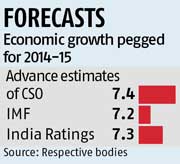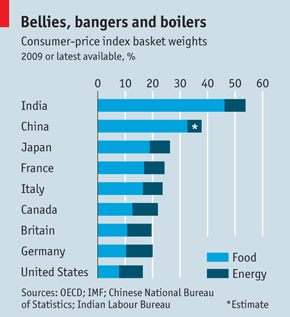Suraj wrote:Amit, thanks for those two references. They clearly take on the argument of 'food processing will make food expensive for poor SDREs' claim.
Suraj,
Your welcome. The supply side bottleneck which the current government is trying to solve is only part of the problem of what ails our agriculture. The other, IMO, is the outdated policy measures. It's instructive to compare Chinese agriculture with that of India. One striking similarity between the two countries is that both have very small farm sizes, in fact average Chinese farm sizes are marginally smaller than Indian ones.
And yet productivity is streets ahead and some of the policy reasons for this would surprise many here as these very prescriptions are decried as being anti-farmer!
Here's a slightly dated but still relevant comparative analysis which has a number very interesting insights/nuggets:
COMPARATIVE STUDY OF AGRICULTURE IN INDIA, CHINA AND US
Some excerpts:
Although, in both countries the major emphasis is on rapid industrialization because of the predominantly agrarian nature of the economies, the agricultural sector provides the basic foundation for industrial expansion with supplies of food, raw materials, and labour, with markets for industrial goods and with foreign exchange earned through exports of primary products.
However, while India’s agricultural sector is growing by about 2.5 per cent; China’s has been steadily growing at between 4 and 5 per cent over the last 15 years. By 2005, China had in fact emerged as the world’s third largest food donor. China with lesser cultivable land produces double the food grains, at 415 million tons per year compared with India’s 208 million tons per year
According to the Food and Agricultural Organisation (FAO), the average yield of rice in India between 2003 and 2005 was 3,034 kilograms per hectare. In contrast, the comparative figure for China was more than double at 6,233 kg/ha. For wheat the corresponding figures were 2,688 kg/ha for India compared to 4,155 kg/ha for China, while for rape and mustard India averaged 909 kg/ha to China’s 1,778 kg/ha. For rice the trend rise over 15 years leading up to 2005 in India was only 1 per cent, less than half of China’s 2.1 per cent. According to statistics from the International Rice Research Institute, India produced 124 million tonnes of rice compared to China’s 186 million tonnes in 2004, despite having almost doubled the area under paddy cultivation (42 million hectares vs. 28 million hectares). Regarding rape and mustard, the trend rise in China marked an even larger stride — 3 per cent compared to the India’s mincing step forward of 0.6 per cent. Other crops such as wheat and groundnut reveal similar trends, with China well in the lead.
The widest divergence between India and China, however, is in the profitable horticultural sector with the production of fruits and vegetables in China leaping up from 60 million tonnes in 1980, roughly comparable to India’s 55 million tonnes at the time, to 450 million tonnes in 2003, way ahead of India’s corresponding 135 million tonnes. China’s added advantage lies in the more diversified composition of its agricultural sector, with animal husbandry and fisheries accounting for close to 45 per cent of the total in 2005, compared to less than 30 per cent in India. China has thus clearly developed a more diversified set of instruments than its southern neighbour for increasing net farm incomes.
Written by a team headed by C. Rangarajan, the report points out that Indian agriculture is placed favourably when compared to China in terms of quantity of agricultural land (161 million hectares vs. 130 million hectares), irrigated land (55.8 million hectares vs. 54.5 million hectares), average farm size (1.4 hectares vs. 0.4 hectares) and farm mechanisation (15.7 tractors per 1000 hectares vs. 7 tractors per 1000 hectares). Thus most of the usual excuses for India’s poor agricultural performance do not hold up when it is compared to China.
The reasons for China having outperformed India in agriculture are threefold: technological improvements accruing from research and development, investment in rural infrastructure and an increasingly liberalised agricultural policy.
In China, the Central government invested RMB 12 billion ($1.5 bn) in agricultural research in 2006, up from RMB (Renminbi means, the people’s money, is the currency of China, is also called Yuan. 1 dollar = approx. 6.9 RMB/Yuan) 4 billion in 1995. The country currently has over 1,000 R&D centres devoted to agriculture and there is a huge push towards developing new strains of plants. Some two-thirds of all cotton grown in China is BT cotton and nearly 100 per cent of paddy is of a modern variety. {Remember the opposition to BT Cotton in India?} According to the China Agricultural Year Book 2005, the Chinese authorities received and assessed as many as 2,046 applications for the registration of new plant varieties in the five years between 1999 and 2004. In contrast, despite India having the largest number of agricultural scientists on the government payroll in the world — over 30,000 — their research track record has been so abysmal that India’s current agricultural productivity is roughly equal to what China achieved in the mid-1980s.
Far from developing new strains, the number of field crop varieties released by the Indian Council of Agricultural Research (ICAR) actually fell by 50 per cent between 1997 and 2001, despite the fact that there was a sharp and sustained increase in funding for the organisation. One reason for the poor results of India’s R&D in agriculture is the state of the country’s agricultural universities. According to a report, 90 per cent of the Punjab Agricultural University’s budget is eaten up by staff salaries with only 3 per cent going to research.
In contrast, most agricultural research centres in China must use Central government funding purely for research. Funds relating to salaries and other administrative incidentals must be covered by funds generated by the centres themselves. The centres and their scientists are thus encouraged to engage in joint ventures with private sector companies to form commercial spin-offs from their research. {Remind me which is the Communist country and which is the Free Market Capatalist country}
And here lies the nub of the difference:
In contrast, the main form of government assistance to farmers has been through subsidies rather than investment in India. Unlike India, China does not provide its farmers with subsidies for fertilizers or power. The RMB 340 billion ($44.7 bn) spent on rural agricultural investment by the Chinese government in 2006, only about 5 per cent was by way of subsidies.
“There is some debate regarding subsidies and their utility in China, but the government realises that on the whole subsidies are against market reforms. They distort the market as well as reduce resource efficiency. China’s relative agricultural success to an increasingly liberalised farm policy with a focus on “efficiency as much as on equity.”





